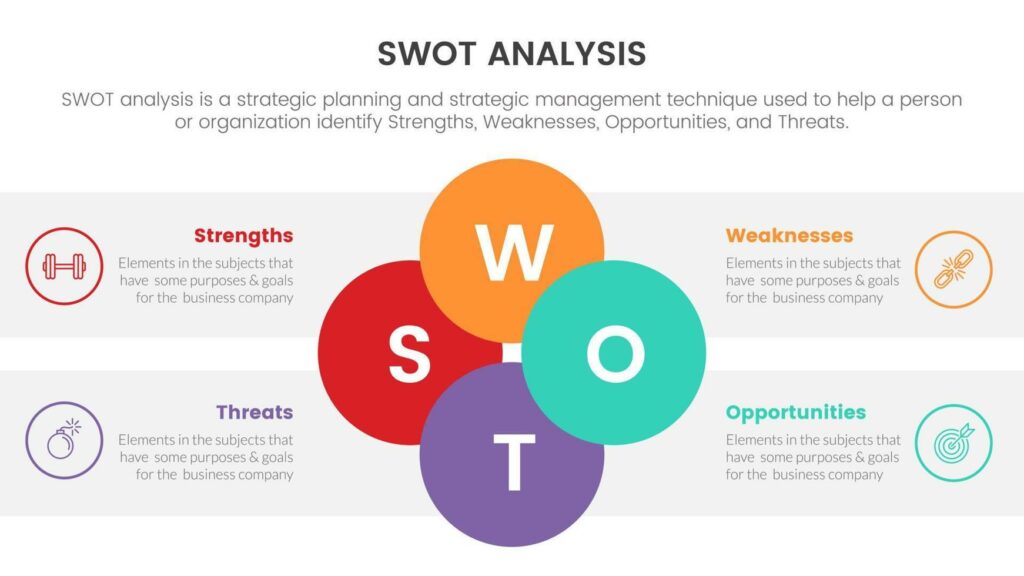Understanding your rivals is crucial for success. Competitor research provides valuable insights into market trends, customer preferences, and industry benchmarks, enabling businesses to make informed strategic decisions.
This comprehensive guide will walk you through the essentials of competitor research, from setting clear objectives and identifying competitors to analyzing their products, services, and financial performance. Equip yourself with the knowledge to stay ahead and achieve sustained competitive advantage in your market.
Table of Contents
What is Competitor Research?
Competitor research involves the systematic collection and analysis of information about rival businesses in your market. This process helps you understand what your competitors are doing, how they are performing, and what strategies they use. It enables you to make informed decisions, stay ahead of industry trends, and enhance your own business strategy.
This research typically includes examining several things about your competitor. These include competitors’ products or services, marketing tactics, pricing strategies, customer reviews, and overall market positioning. By studying these aspects, businesses can identify strengths and weaknesses in their own operations and uncover opportunities for improvement or innovation.
Key Concepts
At its core, competitor research is about gathering intelligence that helps your business remain competitive. Competitive analysis is the process of identifying your competitors and evaluating their strategies to determine their strengths and weaknesses relative to your own business.
Benchmarking involves comparing your business processes and performance metrics to those of leading competitors to identify best practices and areas for improvement. Market positioning is how competitors position themselves in the market. This can help you find unique selling points for your own products or services.
Competitor Research vs Market Research
While competitor research focuses specifically on analyzing competitors, market research is a broader term that encompasses understanding the overall market landscape.
Competitor research concentrates on specific competitors. It looks at their strategies, strengths, weaknesses, and market position. Market Research involves studying the entire market. This includes customer demographics, market trends, industry conditions, and broader economic factors.
Both types of research are crucial. But competitor research allows you to zero in on direct threats and opportunities related to your specific business context.
Why is it Crucial?
Competitor research is essential for several reasons. By observing what your competitors are doing, you can spot emerging trends in your industry. For example, if many competitors are adopting a new technology, it may indicate a broader industry movement that your business should consider.
Competitor research can reveal what customers like or dislike about your competitors’ products or services. By analyzing customer reviews, feedback, and social media interactions, you can gain insights into customer needs and preferences.This will inform your own product development and marketing efforts.
Benchmarking Performance: Comparing your performance against competitors helps you identify areas where you are excelling and areas that need improvement. Benchmarking can be applied to various aspects of your business.These include product quality, customer service, pricing, and marketing effectiveness.
Types of Competitors
Understanding the different types of competitors is crucial for effective competitor research. There are three main types:
Direct Competitors
These are businesses that offer similar products or services to the same target market as you. For example, if you own a coffee shop, other coffee shops in your area are your direct competitors. Analyzing direct competitors helps you understand what you need to do to attract the same customers.
Indirect Competitors
These competitors offer different products or services that satisfy the same customer needs. For instance, a bakery could be an indirect competitor to a coffee shop if customers choose between buying coffee from either place. Studying indirect competitors can help you identify alternative ways to meet customer needs and differentiate your offerings.
Potential Competitors
These are businesses that are not currently in your market but could enter in the future. This could include companies in related industries or new startups with innovative solutions. Keeping an eye on potential competitors helps you anticipate market changes and stay prepared for new challenges.
Preparing for Competitor Research
Before diving into competitor research, it’s crucial to set clear objectives. Having a well-defined plan will ensure that your research is focused and effective.
1. Set Your Goals
Start by identifying what you want to achieve with your competitor research. Common goals might include:
- Understanding Market Position: Knowing where your business stands in comparison to competitors.
- Identifying Strengths and Weaknesses: Recognizing what you and your competitors do well and where there’s room for improvement.
- Discovering Opportunities: Spotting gaps in the market or new trends that you can capitalize on.
- Improving Strategies: Enhancing your marketing, sales, or product development strategies based on insights from competitors.
Once you’ve defined your goals, outline the specific outcomes you expect. For instance, if your goal is to improve your marketing strategy, an expected outcome could be identifying three new marketing tactics used by competitors that you can adapt.
2. Prioritize Information Needs
Not all information about your competitors will be equally important. Prioritize the information you need based on your goals. For example, your main objective might be to improve product development.
So you might prioritize information about competitors’ product features, customer feedback, and innovation efforts. Conversely, if your focus is on marketing, prioritize data related to competitors’ advertising campaigns, social media presence, and branding strategies.
By setting clear objectives and prioritizing information needs, you streamline your research process and ensure that you gather the most relevant and actionable insights.

3. Identify Competitors
The next step in preparing for competitor research is to identify who your competitors are. This involves using various tools and methods to find businesses that pose a competitive threat.
Several tools and methods can help you identify competitors:
- Search Engines: Simple Google searches using keywords related to your business can reveal direct and indirect competitors.
- Industry Reports: Market research reports often list key players in your industry.
- Social Media: Platforms like LinkedIn, Twitter, and Facebook can show which companies are active in your field and engaging with your target audience.
- Customer Feedback: Surveys and reviews can reveal which other businesses your customers are considering or using.
- Competitor Analysis Tools: Software like SEMrush, Ahrefs, and SimilarWeb can provide detailed information on competitors’ online activities and performance.
Not all competitors are worth the same level of scrutiny. Select competitors to research based on criteria such as:
- Market Share: Focus on businesses that hold significant market share.
- Growth Rate: Look at competitors that are growing quickly, as they may be doing something particularly effective.
- Reputation: Consider both well-established brands and emerging companies with strong reputations.
- Relevance: Prioritize competitors that directly compete for your target audience.
By carefully selecting which competitors to research, you ensure that your efforts are concentrated on the most influential and relevant players in your market.
4. Gather Basic Information
Once you’ve identified your competitors, the next step is to gather basic information about them. This foundational data provides context for deeper analysis.
Start with creating detailed profiles for each competitor. A company profile should include:
- Company History: A brief overview of the company’s background, founding date, and key milestones.
- Ownership and Structure: Information about the company’s ownership, whether it’s privately held or publicly traded, and its organizational structure.
- Locations: The physical locations of the company’s headquarters, branches, and any international presence.
- Key Personnel: Names and roles of key executives and decision-makers.
Understanding what your competitors offer is crucial for identifying how you can differentiate your business. Examine their products and services by looking at:
- Product Range: The variety and types of products or services offered.
- Features and Benefits: Key features of each product or service and the benefits they provide to customers.
- Pricing: Pricing strategies and structures, including any discounts, bundles, or special offers.
- Customer Reviews: Feedback from customers about the quality, usability, and satisfaction with the products or services.
This information helps you compare your offerings with those of your competitors and identify areas where you can innovate or improve.
Primary Research Methods
Primary research involves collecting data directly from sources rather than relying on existing data. This approach provides fresh, specific insights tailored to your needs.
Surveys and Questionnaires
Surveys and questionnaires are a straightforward way to gather information directly from people. They can help you understand customer opinions, preferences, and experiences with your competitors. Here’s how to effectively use them:
- Design the Survey: Keep questions clear and concise. Use a mix of multiple-choice, rating scales, and open-ended questions to gather both quantitative and qualitative data.
- Distribute the Survey: Use online platforms like SurveyMonkey, Google Forms, or social media to reach a wide audience. Ensure your survey reaches a representative sample of your target market.
- Analyze Results: Look for patterns and trends in the responses. For example, if many respondents rate a competitor’s customer service highly, it indicates an area where your business might need improvement.

Interviews
Interviews provide deeper insights than surveys by allowing for more detailed and nuanced responses. They can be conducted with customers, industry experts, or even former employees of competitors.
- Prepare for the Interview: Develop a list of open-ended questions that encourage detailed responses. Focus on areas such as customer satisfaction, product features, and perceived strengths and weaknesses of competitors.
- Conduct the Interview: Choose a comfortable setting, whether in-person, over the phone, or via video conferencing. Record the conversation (with permission) to ensure you capture all details.
- Analyze Insights: Review the interview transcripts to identify key themes and insights. Interviews can reveal unique perspectives that surveys might miss.
Focus Groups
Focus groups involve gathering a small group of people to discuss their opinions and experiences. This method provides rich, qualitative data and can reveal how customers feel about your competitors.
- Select Participants: Choose a diverse group of participants that represent your target market.
- Facilitate the Discussion: Use a moderator to guide the conversation and ensure all participants have the chance to speak. Prepare a discussion guide with key topics to cover.
- Record and Analyze: Record the session and take notes on key points. Analyze the discussion to identify common themes and unique insights.
Secondary Research Methods
Secondary research involves collecting existing data from various sources. This method is usually quicker and less expensive than primary research.
Online Research
The internet is a rich source of information about competitors. Use search engines, company websites, and online databases to gather data.
Conduct Google searches using relevant keywords to find articles, press releases, and other online content about competitors. Explore competitors’ websites to gather information about their products, services, pricing, and customer testimonials.
Access databases like Statista, IBISWorld, and others for industry-specific data and reports.
Industry Reports
Industry reports provide comprehensive overviews of market conditions, trends, and key players. These reports are often produced by market research firms and industry associations.
Look for reports from reputable sources such as Nielsen, Gartner, and Forrester. Some reports may be available for free, while others might require a purchase.
Use these reports to understand broader market trends, compare competitor performance, and identify emerging opportunities.
Financial Statements
Public records and financial statements offer detailed insights into competitors’ financial health and business operations. Access public records through government databases and regulatory agencies. These records can include business registrations, patents, and legal filings.
For publicly traded companies, financial statements are usually available online. Analyze these documents to understand revenue, profit margins, and cost structures.
Tools for Competitor Research
Various online tools and software can streamline your competitor’s research process and provide detailed analytics.
Tools like SEMrush, Ahrefs, and SimilarWeb help you analyze competitors’ online activities, including their website traffic, SEO strategies, and digital advertising.
SEMrush provides insights into competitors’ search engine rankings, keywords, and backlinks. This tool can help you understand their SEO strategies and identify potential keywords for your own campaigns.
Ahrefs offers detailed information about competitors’ backlinks, keyword rankings, and content performance. SimilarWeb analyzes website traffic, audience demographics, and referral sources. This tool helps you understand where competitors’ traffic comes from and how they engage their audience.
Social media monitoring tools track competitors’ social media activities and audience engagement. Hootsuite allows you to monitor competitors’ social media posts, mentions, and engagement metrics across multiple platforms.
Sprout Social provides detailed analytics on competitors’ social media performance, including engagement rates, audience growth, and content effectiveness.
Competitive Analysis Frameworks
Frameworks like SWOT and PESTLE provide structured approaches to analyzing competitors.
SWOT analysis evaluates competitors’ strengths, weaknesses, opportunities, and threats. This framework helps you understand their competitive advantages and areas of vulnerability.

PESTLE Analysis examines political, economic, social, technological, legal, and environmental factors affecting competitors. This broader analysis helps you understand external factors that could impact your market.
Analyzing Competitor Data
Once you have gathered data on your competitors, the next step is to analyze this information to gain insights that will inform your business strategies. This involves looking closely at various aspects of your competitors’ operations.
Product Features and Benefits
Understanding the features and benefits of your competitors’ products or services helps you see how they meet customer needs and where your offerings might fall short.
Look at the specific characteristics of competitors’ products, such as design, functionality, and quality. For example, if a competitor’s smartphone has a longer battery life and a better camera than your model, these features are significant advantages.
Consider how these features translate into benefits for customers. A product feature like water resistance in a smartwatch becomes a benefit when it allows customers to use it in all weather conditions and during swimming.
Pricing Strategies
Analyzing how competitors price their products helps you understand their pricing strategies and position your own products competitively.
Look at whether competitors use cost-plus pricing, value-based pricing, penetration pricing, or other models. For instance, a competitor might price their product low to attract customers quickly (penetration pricing) or high to reflect premium quality (value-based pricing).
Examine any discounts, bundles, or seasonal promotions they offer. Understanding these can help you adjust your pricing strategy or create competitive offers.
Promotional Tactics
Competitors’ advertising and promotional tactics reveal how they attract and retain customers.
Identify where competitors advertise, such as online (Google Ads, social media), print (magazines, newspapers), and broadcast (TV, radio).
Look at the types of promotions they use, such as discounts, loyalty programs, or limited-time offers. For instance, a competitor might run frequent flash sales or offer free trials to attract new customers.
Revenue and Profit Margins
Revenue and profit margins provide a snapshot of competitors’ financial health and market success. Look at the total sales revenue generated by competitors. This can indicate their market share and growth potential.
Examine net profit margins to understand how efficiently competitors convert revenue into profit. A higher profit margin indicates better cost control and pricing strategies.
Financial Health Indicators
Financial health indicators provide a broader view of competitors’ overall financial stability. Assess the level of debt competitors carry and how it affects their financial stability. High debt levels might indicate financial strain.
Examine cash flow statements to understand how well competitors manage their cash. Positive cash flow indicates good financial health. Look at any recent investments or capital expenditures, which can indicate growth strategies and financial confidence.
Find Your Competitive Edge
Competitor research is a vital tool for any business seeking to thrive in a competitive market. By systematically analyzing competitors’ products, services, market positioning, and marketing strategies and financial performance, businesses can gain valuable insights to inform strategic decisions.
This comprehensive approach helps identify strengths and weaknesses, uncover opportunities, and stay ahead of industry trends. Ultimately, thorough competitor research enables businesses to enhance their offerings, improve customer satisfaction, and achieve sustained competitive advantage.
Ready to outsmart your competition and boost your business? Discover how EvolveDash can transform your digital marketing strategy today!
FAQs
1. How often should I conduct competitor research?
Competitor research should be an ongoing process, but a thorough review every 6-12 months is recommended.
2. What are the best free tools for competitor research?
Google Search, Google Trends, Ubersuggest, and social media insights are useful free tools.
3. Can small businesses benefit from competitor research?
Yes, even small businesses can gain valuable insights to improve strategies and compete effectively.
4. What are the risks of ignoring competitor research?
Without competitor research, businesses may miss market trends, lose customers to better-positioned competitors, or fail to innovate.
5. How do I use competitor research to improve my business strategy?
Use findings to refine marketing, pricing, product development, and customer service strategies.



















